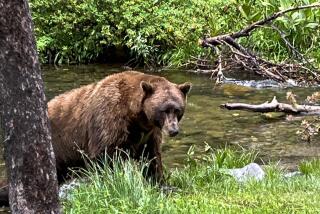Cubs Orphaned : Hunters Asked to Spare Mother Bears
- Share via
ANCHORAGE, Alaska — With lightning speed, before the zookeeper could react, the 3-month-old polar bear cub struck the hand that was holding the bowl of fatty milk, drawing blood with its baby claws.
The cuddly cub’s frisky attack may not have been the thanks its feeder expected, but it was a healthy sign for wildlife officials nursing the motherless bear, its brother and another set of twins left orphans by hunters’ bullets.
The aggressive 20-pound cubs, mere hints of the half-ton monsters that roam wild on the Arctic ice pack, already are capable of inflicting nasty scratches and bloody bites.
But these four growling cubs, the first polar bear orphans recovered from the Alaska wild since 1977, will never be wild ice bears. In separate incidents over three weeks, they lost their mothers before they could learn survival skills.
Two had never set foot out of the birth den until their mother lost her life charging a hunter. Two others had only just emerged from the den. All four orphans got free rides from Bering Sea coastal towns to Anchorage, site of the Alaska Zoo, a temporary home until qualified zoos are found to take them.
The cubs are past the danger point--and the crying stage. Indeed, on their first night in Anchorage, zoo veterinarian Tex Coady said: “They cried a lot because they missed their mother.”
While Anchorage zoo visitors ogle the white bundles of fur until they are sent off to new homes, wildlife officials in Alaska ponder the fate of female bears roaming icy coasts along northern and northwestern Alaska.
The Eskimo hunters that brought down these cubs’ mothers did nothing illegal. The federal Marine Mammal Protection Act that protects polar bears allows Alaska natives--and no one else--to hunt the animals for subsistence use. Inupiat Eskimos eat polar bear meat and use hides for barter and for clothes like mukluks (boots), parkas and mittens.
But the hunts have brought to light a concern that is not new: hunting female bears.
Of the 128 polar bears taken in an average year by Alaska Eskimos, one-third are female. Alaska’s polar bear population, between 3,000 and 5,000, appears to be stable, said Scott Schliebe, the wildlife agency’s polar bear coordinator.
There are between 20,000 and 40,000 polar bears in the world--in Russia, Canada, Greenland, Norway and Alaska, according to a study by Steven Amstrup of the federal Fish and Wildlife Service. He found hunting strictly regulated everywhere except Alaska, where federal law permits unrestricted hunting by natives.
Female bears nearly always are pregnant or teaching their cubs how to survive, Amstrup said. In suggesting the first restrictions on Eskimo hunters, he said female bears should be legally protected.
Schliebe said Fish and Wildlife Service recommendations for changes in the law were nixed by higher-ups in the Department of Interior, but he declined to discuss internal disagreements.
However, Schliebe said his agency later this year will attempt to achieve some of the same goals through administrative regulations. All polar bear hunters will be asked to report every kill and to take pains to avoid female bears.
Native hunters in villages in northern Alaska and in Canada’s Northwest Territories earlier this year devised their own polar bear management plan--without U.S. and Canadian government involvement--because of concerns that the relatively small, isolated Beaufort Sea polar bear population with low reproductive potential is too vulnerable.
The North Slope Borough in northern Alaska reached an agreement with the Inuvialuit Game Council from Inuvik in Canada that is more restrictive than federal laws and intended to keep the population healthy, partly by protecting females.
Self-imposed regulations in the Eskimos’ agreement affecting five Alaska communities and four in Canada declare that bears in dens and those constructing dens are protected.
More to Read
Sign up for Essential California
The most important California stories and recommendations in your inbox every morning.
You may occasionally receive promotional content from the Los Angeles Times.













